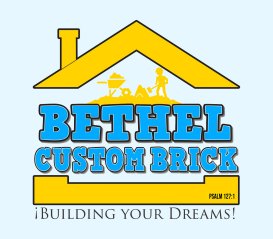Choosing sustainable materials is increasingly important for homeowners looking to minimize their environmental impact. Brick has long been a popular building material for its durability and aesthetic appeal, but it also offers significant environmental benefits. From energy efficiency to low maintenance, brick is an eco-friendly choice for home exteriors. In this article, we’ll explore the environmental benefits of using brick and why it’s a sustainable option for your home.
1. Natural, Abundant Material
Why It’s Eco-Friendly:
Brick is made from natural materials—primarily clay and shale—abundant resources that have minimal impact on the environment when responsibly sourced. Unlike synthetic building materials, bricks don’t require extensive processing, making them a low-impact, sustainable choice.
Environmental Benefits:
Since bricks are composed of natural elements, they are non-toxic and have minimal environmental impact during production. Additionally, bricks are recyclable, meaning old bricks can be repurposed rather than ending up in a landfill.
2. Energy Efficiency and Insulation
Why It’s Eco-Friendly:
Brick’s thermal mass—the ability to store and slowly release heat—helps stabilize indoor temperatures, making it easier to keep your home warm in the winter and cool in the summer. This reduces the need for heating and cooling, ultimately lowering your energy consumption and carbon footprint.
Environmental Benefits:
By providing natural insulation, brick helps lower energy costs and reduces greenhouse gas emissions associated with heating and cooling. Homes with brick exteriors are generally more energy-efficient, making brick a smart choice for those aiming to reduce their home’s environmental impact.
3. Long-Lasting and Durable
Why It’s Eco-Friendly:
One of brick’s most notable benefits is its durability. Brick can withstand extreme weather conditions, from high winds and heavy rains to fire and pest damage. This resilience means brick structures can last for decades, or even centuries, without needing replacement.
Environmental Benefits:
Because brick has such a long lifespan, it significantly reduces the need for replacement materials and repairs, minimizing resource consumption and waste generation. Compared to materials that require frequent maintenance or replacement, brick’s durability makes it a sustainable choice that contributes to a circular economy.
4. Low Maintenance Requirements
Why It’s Eco-Friendly:
Brick is naturally resistant to weathering, mold, and pests, meaning it requires very little maintenance over time. Unlike materials like wood siding, which may need frequent repainting, sealing, or pest control, brick retains its integrity and appearance with minimal upkeep.
Environmental Benefits:
Low-maintenance materials like brick reduce the need for chemical cleaners, paints, and coatings, which can introduce pollutants into the environment. Brick’s natural resistance to damage helps reduce overall maintenance costs and lessens the environmental impact associated with upkeep.
5. Fire and Weather Resistance
Why It’s Eco-Friendly:
Brick is highly resistant to fire and extreme weather events, making it one of the safest building materials available. This resistance reduces the likelihood of needing extensive repairs or replacements due to damage from natural disasters, storms, or fires.
Environmental Benefits:
By reducing the frequency and extent of repairs, brick helps minimize the resources and waste associated with rebuilding or renovating. Choosing a fire-resistant material like brick also reduces the risk of fire-related pollutants and debris entering the environment, contributing to a safer and more sustainable home.
6. Recyclable and Reusable Material
Why It’s Eco-Friendly:
When brick buildings are dismantled, the bricks can often be cleaned and reused in new construction, reducing the demand for new materials. Reclaimed bricks are increasingly popular in sustainable building projects and add character to new structures while conserving resources.
Environmental Benefits:
Reusing bricks reduces waste, conserves raw materials, and lowers the energy required for manufacturing new bricks. By choosing reclaimed bricks or recycling old bricks, homeowners and builders contribute to a sustainable, circular building process that minimizes environmental impact.
7. Improved Indoor Air Quality
Why It’s Eco-Friendly:
Brick is a natural, non-toxic material that doesn’t release volatile organic compounds (VOCs) or harmful chemicals into the air. This makes it an excellent choice for homeowners concerned about indoor air quality and health.
Environmental Benefits:
Brick helps maintain a healthy indoor environment, free from toxic emissions. Unlike some synthetic building materials, which can release harmful pollutants into the air, brick’s natural composition contributes to better air quality, benefiting both occupants and the environment.
8. Reduced Heat Island Effect
Why It’s Eco-Friendly:
The heat island effect occurs in urban areas where certain building materials absorb and radiate excessive heat, raising local temperatures. Bricks, especially lighter-colored ones, reflect more sunlight and retain less heat compared to materials like asphalt or dark siding.
Environmental Benefits:
Using brick in urban areas can help reduce the heat island effect, leading to cooler cities and a reduced need for air conditioning. This contributes to lower energy usage and helps mitigate the environmental impact of rising temperatures in densely populated areas.
9. Lower Carbon Footprint with Sustainable Manufacturing
Why It’s Eco-Friendly:
The brick industry has increasingly adopted sustainable manufacturing practices, using renewable energy sources, recycling waste materials, and reducing emissions. Many brick manufacturers now work to minimize their carbon footprint, making brick a greener choice.
Environmental Benefits:
Eco-friendly brick manufacturing helps reduce overall emissions and lowers the carbon footprint of building materials. By choosing bricks produced by environmentally conscious manufacturers, homeowners can support sustainable practices and reduce their home’s environmental impact.
Final Thoughts: Brick as a Sustainable Choice for Home Exteriors
Brick is a building material that not only offers durability and beauty but also provides substantial environmental benefits. From energy efficiency and low maintenance needs to recyclability and improved indoor air quality, brick is a sustainable choice that aligns with eco-conscious living. By choosing brick for your home’s exterior, you’re investing in a material that stands the test of time and contributes to a healthier planet.
If you’re looking to build or renovate with sustainability in mind, brick is an ideal option that combines aesthetics with environmental responsibility. Embrace the benefits of brick to create a home that’s both resilient and eco-friendly.


